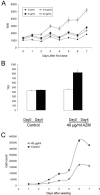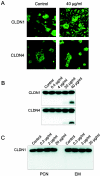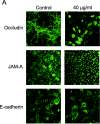Novel effects of azithromycin on tight junction proteins in human airway epithelia
- PMID: 16641453
- PMCID: PMC1472195
- DOI: 10.1128/AAC.50.5.1805-1812.2006
Novel effects of azithromycin on tight junction proteins in human airway epithelia
Abstract
The macrolide antibiotic azithromycin improves lung function and prognosis among patients with cystic fibrosis or diffuse panbronchiolitis, independently of bacterial eradication. Anti-inflammatory effects have been implicated, but data from in vivo studies are scarce, and the link between abnormal electrolyte content in airway surface liquid and bronchial infections remains uncertain. In the present study, we treated human airway epithelia on filter supports with azithromycin and monitored transepithelial electrical resistance. We found that azithromycin increased transepithelial electrical resistance of airway epithelia in a dose-dependent manner. Immunocytochemistry and Western blotting showed that addition of azithromycin changed the locations of proteins in cell cultures and induced processing of the tight junction proteins claudin-1 and claudin-4, occludin, and junctional adhesion molecule-A. These effects were reversible, and no effect was seen when cells were treated with penicillin or erythromycin. The data indicate that azithromycin increases the transepithelial electrical resistance of human airway epithelia by changing the processing of tight junction proteins. The results are novel and may help explain the beneficial effects of azithromycin in patients with cystic fibrosis, diffuse panbronchiolitis, and community-acquired pneumonia.
Figures





References
-
- Baumann, U., M. King, E. M. App, S. Tai, A. Konig, J. J. Fischer, T. Zimmermann, W. Sextro, and H. von der Hardt. 2004. Long term azithromycin therapy in cystic fibrosis patients: a study on drug levels and sputum properties. Can. Respir. J. 11:151-155. - PubMed
-
- Bradford, M. M. 1976. A rapid and sensitive method for the quantitation of microgram quantities of protein utilizing the principle of protein-dye binding. Anal. Biochem. 72:248-254. - PubMed
-
- Colegio, O. R., C. Van Itallie, C. Rahner, and J. M. Anderson. 2003. Claudin extracellular domains determine paracellular charge selectivity and resistance but not tight junction fibril architecture. Am. J. Physiol. Cell Physiol. 284:C1346-C1354. - PubMed
-
- Colegio, O. R., C. M. Van Itallie, H. J. McCrea, C. Rahner, and J. M. Anderson. 2002. Claudins create charge-selective channels in the paracellular pathway between epithelial cells. Am. J. Physiol. Cell Physiol. 283:C142-C147. - PubMed
-
- Equi, A., I. M. Balfour-Lynn, A. Bush, and M. Rosenthal. 2002. Long term azithromycin in children with cystic fibrosis: a randomised, placebo-controlled crossover trial. Lancet 360:978-984. - PubMed
Publication types
MeSH terms
Substances
LinkOut - more resources
Full Text Sources
Other Literature Sources
Medical
Miscellaneous

